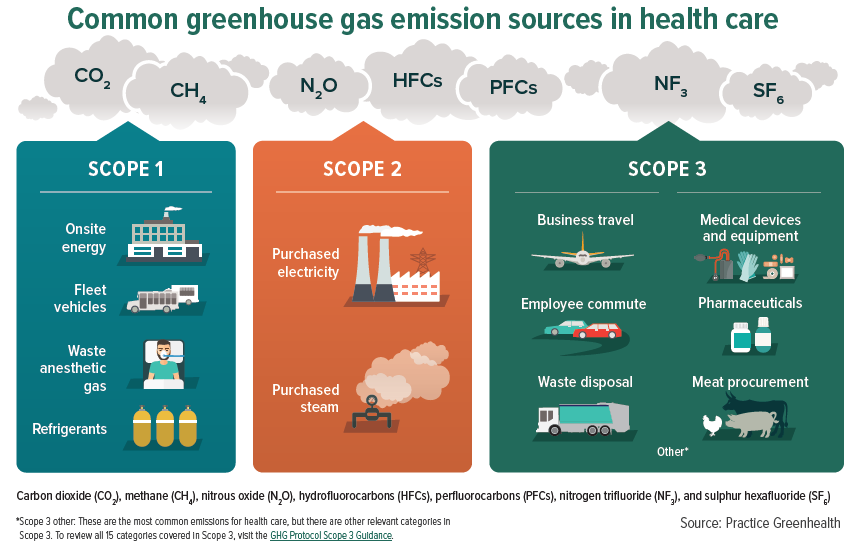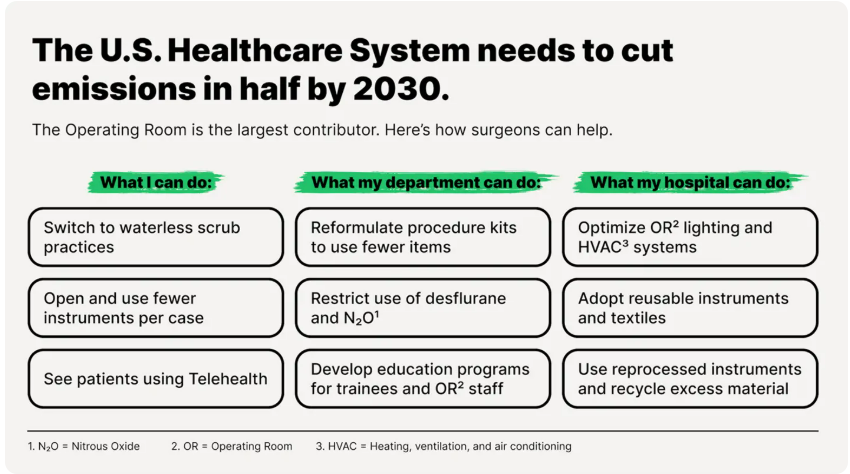31% of waste in the US consists of containers or packaging.
Climate change and pollution pose significant risks to both human health and the ability to provide effective health care. For example, extreme heat and air pollution exacerbate respiratory issues, cardiovascular diseases, and other health conditions and disproportionately affect vulnerable populations. To learn more about how climate change affects health, visit the Centers for Disease Control and World Health Organization.
The health care industry contributes 8.5% of U.S. greenhouse gas emissions (see source here) through:
- Materials and supply chain: Over 70% of a health system’s greenhouse gas emissions are embedded in products and services they buy.
- Waste: Waste generation, hauling, and treatment.
- Energy Consumption: Heating, cooling, lighting, and water use. Healthcare facilities use 2.5 times more energy per square foot than other commercial buildings.
- Anesthetic gases: Emissions from gases used during medical procedures.
- Transportation: Emissions from fleet vehicles and employee commuting.
- Food: The environmental impact of food sourcing and consumption.
Actions you can take to help
The following actions can limit the greenhouse gas emissions from health care, reducing environmental impact and strengthening our mission to "do no harm":
- Energy and Water Conservation: Purchase ENERGY STAR-rated equipment, turn off lights and computers when not in use, and shut down or put equipment into power-savings modes overnight
- Waste Reduction: Identify opportunities to reduce waste by conducting visual trash audits. At WCM, regulated medical waste disposal in 2023 was approximately 7 times more expensive than regular trash disposal, and RMW requires additional processing and hauling that increases the environmental impact. Confidential paper material disposal in 2024 cost 15 times more than recycling. Reducing specialty waste can have both environmental and cost benefits
- Reuse: Opt for reusable and washable items over disposable ones when possible (e.g., gowns). Post items you no longer need on our Resource Sharing Page
- Recycling: Recycle when feasible. Check if recycling signage is posted in your areas and if bins are readily accessible
- Purchase Greener Alternatives: Choose products with minimal packaging, lower toxicity, and less environmental impact (e.g., lower-emission inhalers, anesthetics with a lower global warming potential)
- Alternative transportation: Encourage the use of sustainable transportation options, and consider remote or local attendance options for conferences or convenings
- Sustainable Food Choices: Support sustainable food and beverage options at work
- Advocate for Sustainable Products: Ask vendors to provide eco-friendly alternatives


Source: American College of Surgeons (https://www.facs.org/for-medical-professionals/news-publications/journal...)
Check out the sustainability initiatives at New York Presbyterian Hospital
NewYork-Presbyterian's Committed to Addressing Climate Change

